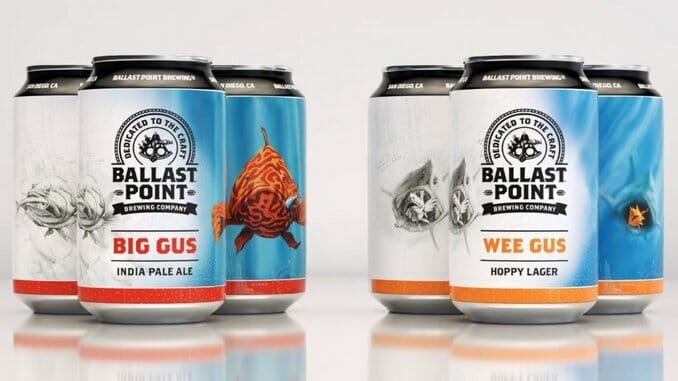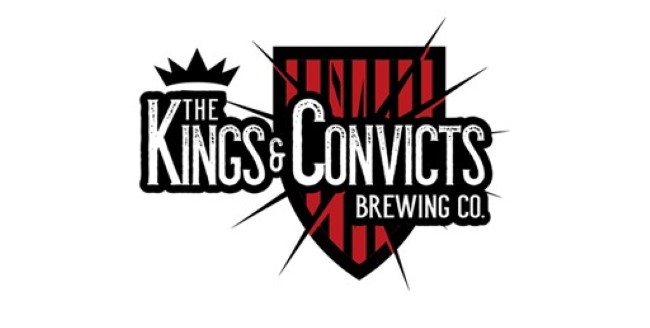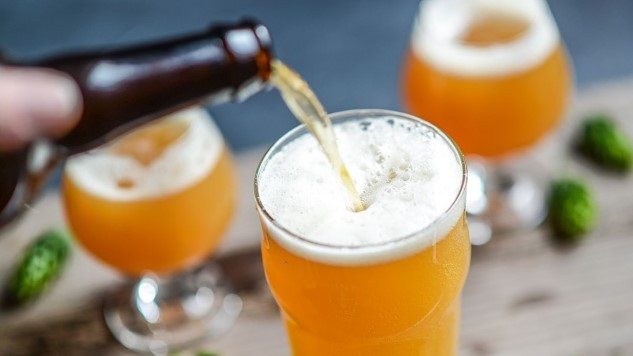Ballast Point’s New “Clear Hazy IPA”: Marketing So Stupid, It Sounds like Satire
Photos via Ballast Point, Kings & Convicts, Brewers Association Drink Features craft beer
It’s been a while at this point since the last time we checked in on the still mind-boggling story of Ballast Point, the San Diego, CA craft beer icon that first sold to Constellation Brands for a record $1 billion back in 2016, at the height of the craft beer boom. In retrospect, this remains by far the most massively overinflated of all overvalued brewery sales of this era, taking place at precisely the moment when the “fruited IPA” wave came to a crest, bringing Ballast Point and Grapefruit Sculpin IPA in particular to their highest point. That year, in 2016, they sold a company record of 431,000 barrels of beer and Constellation was no doubt projecting that the brand would become the next Boston Beer Co.
Fast forward to 2019, and Ballast Point had already become a shell of its former self. Its total production across half a dozen Ballast Point breweries and taprooms around the U.S. had been slashed by more than half, to around 200,000 barrels. Volume growth of the overall craft beer segment had slowed, while the overall number of small brewing operations continued to balloon regardless. Meanwhile, hazy IPA was stealing the thunder of the drier, West Coast IPAs that had long been Ballast Point’s claim to fame, and the new hazy category was propelling other industry stalwarts that adopted it early (such as Sierra Nevada) to new heights. A combination of factors had led Ballast Point to become exactly the sort of big regional brewery that suffered in this era: Overextended, disconnected from the zeitgeist, and abandoned by the same sort of “buy small and local” ethos that decades earlier had fueled its own growth.
Given all that, it wasn’t terribly surprising to see the Ballast Point brand sold again in 2019, for a much lower, never reported figure. What shocked the beer industry at the time was the fact that almost no one had even heard of the brewing entity acquiring Ballast Point, a household name. We had all grown used to buyouts involving AB InBev and Molson Coors swallowing up small fry brewers in the decade prior—the idea of Ballast Point being acquired by a tiny, Chicago-area brewery (600 barrels, in 2019!) called Kings & Convicts Brewing Co. made no sense. It was an out-of-nowhere story that grabbed headlines well outside of traditional beer publications.
 Even now, this brewery is still a largely unknown commodity to most beer geeks.
Even now, this brewery is still a largely unknown commodity to most beer geeks.
And of course, this was all by design. The truth of the matter was of course that Ballast Point wasn’t truly “acquired by Kings & Convicts,” but that it had been snapped up by the well-heeled investors behind Kings & Convicts, which to that point seems to have been more of a hobbyist brewery for its original founders. Acquiring Ballast Point, along with all its brands, breweries and access to the market, was the company’s method of suddenly becoming a national player overnight. As the Chicago Tribune reported at the time, all of this was possible thanks to the investment of wine industry magnate Richard Mahoney, the chairman of the board of The Wine Group, which owns such ubiquitous supermarket wine brands as Cupcake, flipflop and Benziger. The optics of a “little brewery” buying up a big one just made for an irresistible storytelling hook that they naturally exploited.
And if we’re being honest, that story breaking at the end of 2019 was pretty much the last we’d heard about Ballast Point until now. The next year was one of lost time and contraction for the industry, fueled by the obvious on-premise challenges of the COVID-19 pandemic. Many brands went into hunker-down mode, focusing on package store or grocery sales if they had access to those markets, and to-go sales from the brewery if they didn’t. Innovation didn’t get a lot of play during the height of the pandemic, which sort of makes sense.
Now, though, Ballast Point has suddenly reentered the craft beer conversation online, and they’ve done it with a product rollout that is so ludicrous I literally couldn’t help myself from taking the time to pick it apart. Friends, peers, beer lovers everywhere, I ask you to wrap your head around the following line of ad copy: “Clear hazy IPA.” This is Ballast Point’s big new push to capture the public interest; the ultimate craft beer oxymoron. It’s such an absurdity that I find myself asking over and over whether this is actually industry parody of some kind. Did April Fool’s Day arrive a month early? Is this beer accompanied by a “translucent opaque stout” as well?
The beer in question is called Big Gus, and it’s one half of a dyad of new releases dubbed the “Brothers Gus.” Wee Gus is a light, hop-forward, pilsner-esque lager with the ready made selling point of being less than 100 calories for a 12 oz serving. That’s a pretty familiar concept at this point, as seemingly every national brewery has been attempting to get hoppy, sub-100 calorie beers into the market for the last two years, but it’s the description of Big Gus that really boggles the mind here. It’s a pretty standard IPA, save for the fact that Ballast Point is trying to market it as a “clear hazy IPA.” In the process, they’re more or less trying to position the idea of “returning to how IPA was brewed for decades before the last five years” as a novel idea that they just invented. The sheer gall they’re displaying in trying to get the consumer to accept that this is a breakthrough in beer development can’t help but make me stifle a laugh—it does not imply that Ballast Point thinks highly of their customer.
You don’t have to take it from me, though. Here’s an explanation of “clear hazy IPA” development in the brewery’s own words:
Big ideas are typically born after a few beers, so the team sat down and came up with a fun challenge. “What if we made a clear hazy IPA?” As the rest of the industry was deep in the haze craze, the Ballast Point brewers bucked the trend by developing two beers that are clearly different from anything on the market. Ballast Point is well-known for brewing hop-forward beers—the Brothers Gus are no exception—but they are crystal clear by design.
“We always wanted to make a beer that looks different than it tastes,” said Aaron Justus, Ballast Point’s director of research and development. “That’s sort of the creative play with Big and Wee Gus. We sat around as a R&D team and thought ‘how can we make these beers as clear as possible? What kind of scientific processes can we do to ensure that clarity and how can we make them hoppy?’ They also had to be beers that we like to drink.”
Mr. Justus asked some questions there, so I figure I can help out in my limited capacity by answering them.
1. “How can we make these beers as clear as possible?”
I would recommend applying all the techniques that most every craft brewer applied to IPA for the last three decades or so, before hazy IPA was normalized. These techniques, as a whole, are referred to as “fining,” and are something that any homebrewer of the last few decades would be able to tell you about. Fining techniques include the use of ingredients such as Irish moss to help haze-creating proteins drop out of suspension, in addition to low-temperature rest times to encourage yeast to drop out of suspension as well. There are numerous other basic techniques one can use to create clear beer—in fact, I assume someone at Ballast Point probably knows about these techniques because they brew half a dozen other clear IPAs already.
The implication Ballast Point is making is that “if you put a bunch of hops in an IPA, it automatically becomes hazy,” which has never really been true. Dry hopping the hell out of an IPA was already en vogue long before the concept of “hazy IPA” had begun to spread out of New England, and it didn’t stop those beers of an earlier era from being perfectly clear, which was an expectation of quality at the time. True “haze” only arrived in earnest after breweries started purposely cultivating it for its aesthetic appearance, with methods such as using high-protein grists, low-flocculating yeast strains, and stopping filtration in order to make their IPAs look as opaque as possible. In fact, some brewers such as Jean Broillett of Pennsylvania’s Tired Hands Brewing freely admit to using all sorts of unorthodox ingredients such as green apple puree and wheat flour in order to create permanent haze. In other words, “haze” primarily exists because the industry tried their hardest to cultivate it.
 This appearance didn’t just happen on its own.
This appearance didn’t just happen on its own.
Which is all to say: There’s no lost secret to brewing clear beer that Ballast Point needed to rediscover. They know how to brew clear beer already. So does everyone else.
2. “How can we make them hoppy?”
I suggest the use of HOPS IN THE BEER. Put hops in your beer. Lots of hops. This is typically a very effective technique for making a beer hoppy.
In fact, I would recommend that the people at Ballast Point take a little drive up the road to Orange, CA, where a brewery like Green Cheek Beer Co. is currently making immaculately delicious, brilliantly clear IPAs such as Radiant Beauty—beers that contain all the bright tropical fruitiness and “juiciness” of any hazy IPA. The only difference is that the folks at Green Cheek don’t try to make the creation of Radiant Beauty sound like a breakthrough in brewing science; nor do they slap it with a label so profoundly stupid as “clear hazy IPA.” They have a little bit more respect for their audience than that.
Maybe I’m being too harsh to Ballast Point, though. After all, it’s the results that count, right? Maybe Big Gus at least lives up to the promises of its own marketing, packing “hazy IPA” flavor into a “crystal clear” package. Let’s just take a gander at the actual beer, itself …
Hey kids, remember Ballast Point? (Yeah, I had forgotten about them, too.) Well, they’ve just released a new beer called Big Gus, which they describe on their website as a “clear hazy IPA.” And if that isn’t confusing enough, the “crystal-clear” beer looks like this: pic.twitter.com/B1YN5m0Svz
— Stephen Beaumont (@BeaumontDrinks) February 26, 2021
Hold on. Hold on. You’re telling me that after making the entire marketing push around this beer the concept of “clear hazy IPA,” and marketing it as a “crystal clear” revelation that is showing off Ballast Point’s innovation and bucking trends in this marketplace … the freaking beer ISN’T EVEN CLEAR?!? They did all that work, and then went and brewed a beer that is still halfway opaque, and obviously far more hazy than their flagship Sculpin?
There are no words for how immaculately dumb this is. You couldn’t script a more apropos denouement to this story. My brain is currently trying to gnaw its way out of my skull to escape my body.
Congratulations, Ballast Point. If someone in the beer world comes up with a more perfectly botched gimmick in 2021 than “clear hazy IPA, but not actually clear after all,” it will be an amazing achievement. But frankly, I’m doubting that such a thing will be possible.
Jim Vorel is a Paste staff writer and resident beer geek. You can follow him on Twitter for more drink writing.